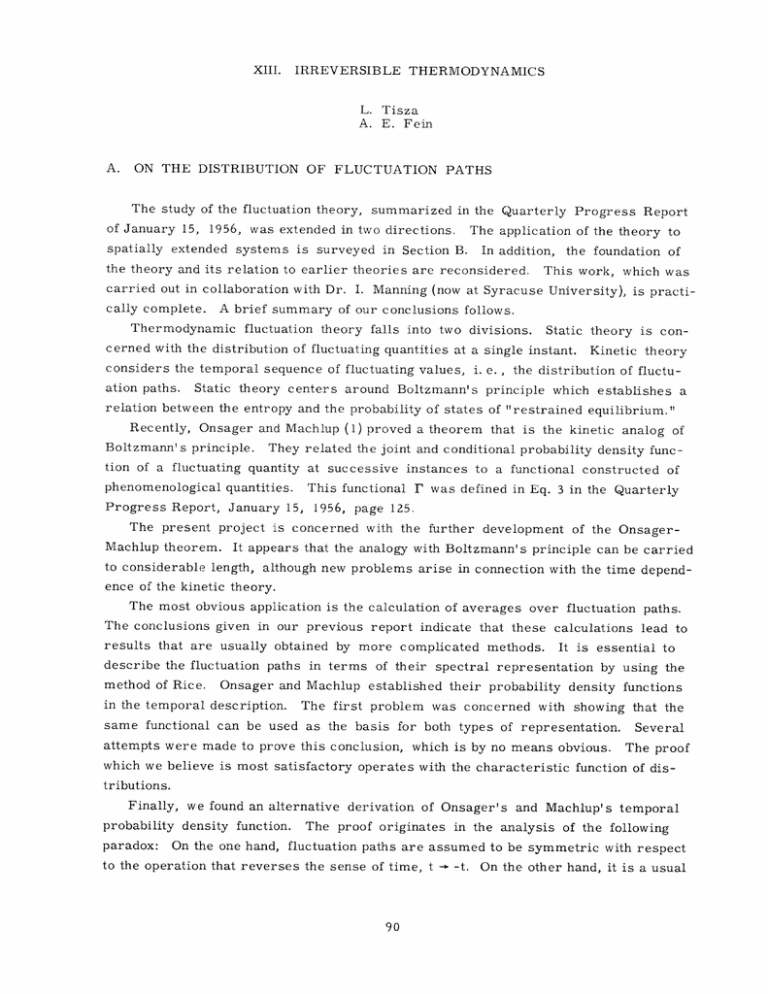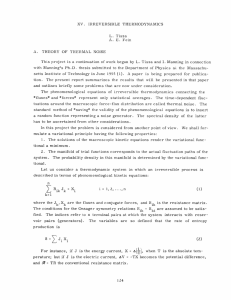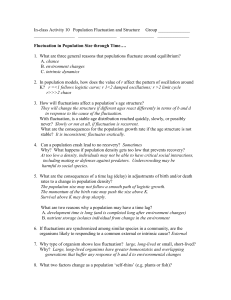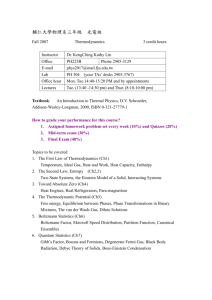XIII. IRREVERSIBLE THERMODYNAMICS L. Tisza A. E.
advertisement

XIII.
IRREVERSIBLE
THERMODYNAMICS
L. Tisza
A. E. Fein
A.
ON THE DISTRIBUTION OF FLUCTUATION PATHS
The study of the fluctuation theory, summarized in the Quarterly Progress Report
of January 15, 1956, was extended in two directions. The application of the theory to
spatially extended systems is
surveyed in Section B.
In addition,
the theory and its relation to earlier theories are reconsidered.
carried out in collaboration with Dr. I.
cally complete.
the foundation of
This work,
which was
Manning (now at Syracuse University), is practi-
A brief summary of our conclusions follows.
Thermodynamic fluctuation theory falls into two divisions.
Static theory is
cerned with the distribution of fluctuating quantities at a single instant.
considers the temporal sequence of fluctuating values, i. e.,
con-
Kinetic theory
the distribution of fluctu-
ation paths.
Static theory centers around Boltzmann's principle which establishes a
relation between the entropy and the probability of states of "restrained equilibrium."
Recently, Onsager and Machlup (1) proved a theorem that is
Boltzmann's principle.
the kinetic analog of
They related the joint and conditional probability density func-
tion of a
fluctuating quantity at successive instances to a functional constructed of
phenomenological quantities. This functional 1 was defined in Eq. 3 in the Quarterly
Progress Report, January 15, 1956, page 125.
The present project is concerned with the further development of the OnsagerMachlup theorem.
It appears that the analogy with Boltzmann's principle can be carried
to considerable length, although new problems arise in connection with the time dependence of the kinetic theory.
The most obvious application is the calculation of averages over fluctuation paths.
The conclusions given in our previous report indicate that these calculations lead to
results that are usually obtained by more complicated methods.
It
is
essential to
describe the fluctuation paths in terms of their spectral representation by using the
method of Rice. Onsager and Machlup established their probability density functions
in the temporal description.
The first problem was concerned with showing that the
same functional can be used as the basis for both types of representation.
attempts were made to prove this conclusion, which is by no means obvious.
Several
The proof
which we believe is most satisfactory operates with the characteristic function of distributions.
Finally, we found an alternative derivation of Onsager's and Machlup's temporal
probability density function.
paradox:
The proof originates in the analysis of the following
On the one hand, fluctuation paths are assumed to be symmetric with respect
to the operation that reverses the sense of time, t -
-t.
On the other hand, it is a usual
(XIII.
IRREVERSIBLE
THERMODYNAMICS)
assumption in irreversible thermodynamics that, on the average, the regression of
fluctuations follows the macroscopic kinetic equation. However, the solutions of the
kinetic equation are not symmetric with respect to time.
Although the Onsager-Machlup
theory implies that it is not inconsistent to mix the time-symmetric and asymmetric
aspects of the theory, it is still of interest to make this consistency more explicit.
Our derivation of the probability density function is based essentially on the analysis
of time symmetry.
One can show that in a certain sense fluctuation paths can be repre-
sented as a combination of falling and rising exponentials corresponding to the regular
and the time-reversed solutions of the kinetic equation. Inserting these functions into
the functional F(ah), we notice that the latter acts like a "filter":
the expression
t2
t
dt
t
is equal to the entropy decrease produced by the time reversed contributions,
while the
entropy increase caused by the regular paths remains unregistered.
It is possible to represent the fluctuation paths in a time-symmetric fashion, and
incorporate in the theory a bias in favor of the forward paths by means of a probability
density function that is some functional of f IF dt. If this qualitative assumption is
granted, the quantitative form of the probability density function can be derived from
generally accepted principles.
The result is precisely the Onsager-Machlup probability
density function which was derived originally by another method.
L. Tisza
References
Machlup, Phys. Rev. 91,
1505;
1512 (1953).
1.
L. Onsager and S.
B.
SPACE-TIME CORRELATIONS IN IRREVERSIBLE THERMODYNAMICS
Irreversible thermodynamics is usually discussed in terms of discrete or continuous systems. In the former case, there is a single variable a that describes the
deviation of an extensive variable from its equilibrium value.
a is a continuous function of the spatial coordinates.
In the continuous system,
The stochastic methods for the
calculation of fluctuations were developed only for discrete systems.
Extension of this
theory to the continuous case seems to be blocked by serious difficulties.
Nevertheless,
there are meaningful problems that would call for the inclusion of
spatial extension in the theory.
time-variable
sense,
Instead of considering correlation matrices only in the
we may want to discuss space-time correlations.
There are
(XIII.
IRREVERSIBLE
THERMODYNAMICS)
propagation problems that are described phenomenologically by the diffusion differential
equation and by the wave equation with a damping term.
It is possible to attack problems of this sort by means of the "cellular method" (1).
Instead of dividing the thermodynamic system into two subsystems,
sion into a large number of identical cells.
we consider a divi-
The fluctuation of a variable is described
by a "vector" {ai}, where the index i runs over all the cells.
The method of computing correlation coefficients which was discussed in the January
report can be applied to this case.
Assuming that periodic boundary conditions exist,
the system takes on a lattice type of translational symmetry and the matrices occurring
in the theory can be simultaneously diagonalized; thus a solution in closed form is
obtained.
In such a way, we arrive at a formal solution of the space-time problems.
The derivation of partial differential equations,
such as the diffusion equation,
requires that the size of the cell be small compared with the macroscopic dimensions
of the system.
It is interesting that letting the size of the cell tend to zero leads to
conceptual difficulties.
becomes finer,
The fractional fluctuation increases as the cellular division
hence we are faced with the limitation of the semiphenomenological
theory.
The case of small cell sizes appears to be the most interesting problem for further
study.
L. Tisza, A. E.
References
1.
M. J.
Klein and L. Tisza, Phys.
Rev. 76,
1861 (1949).
Fein





